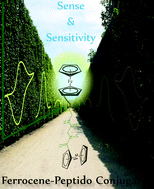The field of chemical and biological sensing is increasingly dependent on the availability of new functional materials that enhance the ability of the system to respond to chemical interactions. Organometallic bioconjugates derived from amino acids, peptides, proteins, peptide nucleic acids, and dendrimers have had a profound effect in this area and have endowed modern sensory systems with a superior performance. Owing to their fairly high stability, solubility in various solvents, and excellent redox properties, ferrocene and ferrocenyl conjugates have emerged as one of the most important classes of materials that enable direct observation of molecular interactions and as electron mediators. The low potential, reversible redox behavior of the ferrocene/ferrocenium couple is a unique property that finds widespread application in the design of sensory platforms. Currently, there is significant drive to exploit new organometallic systems, in which the presence of ferrocene acting as a redox center is critical and allows the design of highly sensitive electrochemical sensors for the sensing and recognition of a vast array of analytes.

You have access to this article
 Please wait while we load your content...
Something went wrong. Try again?
Please wait while we load your content...
Something went wrong. Try again?


 Please wait while we load your content...
Please wait while we load your content...